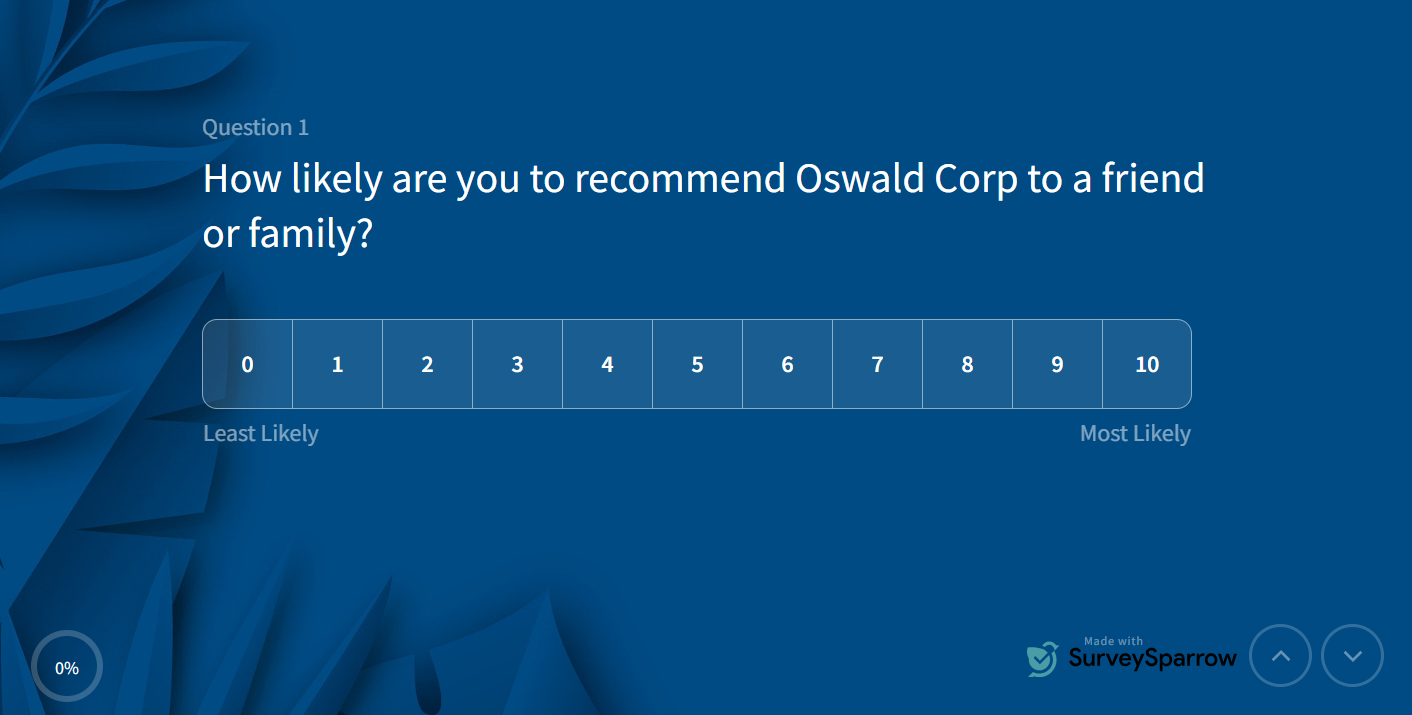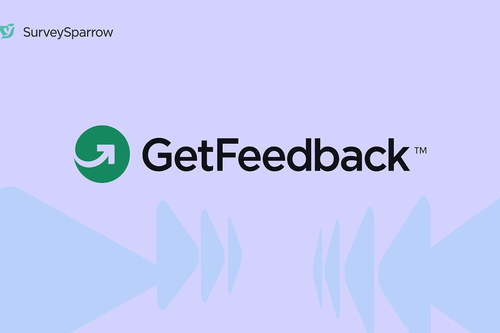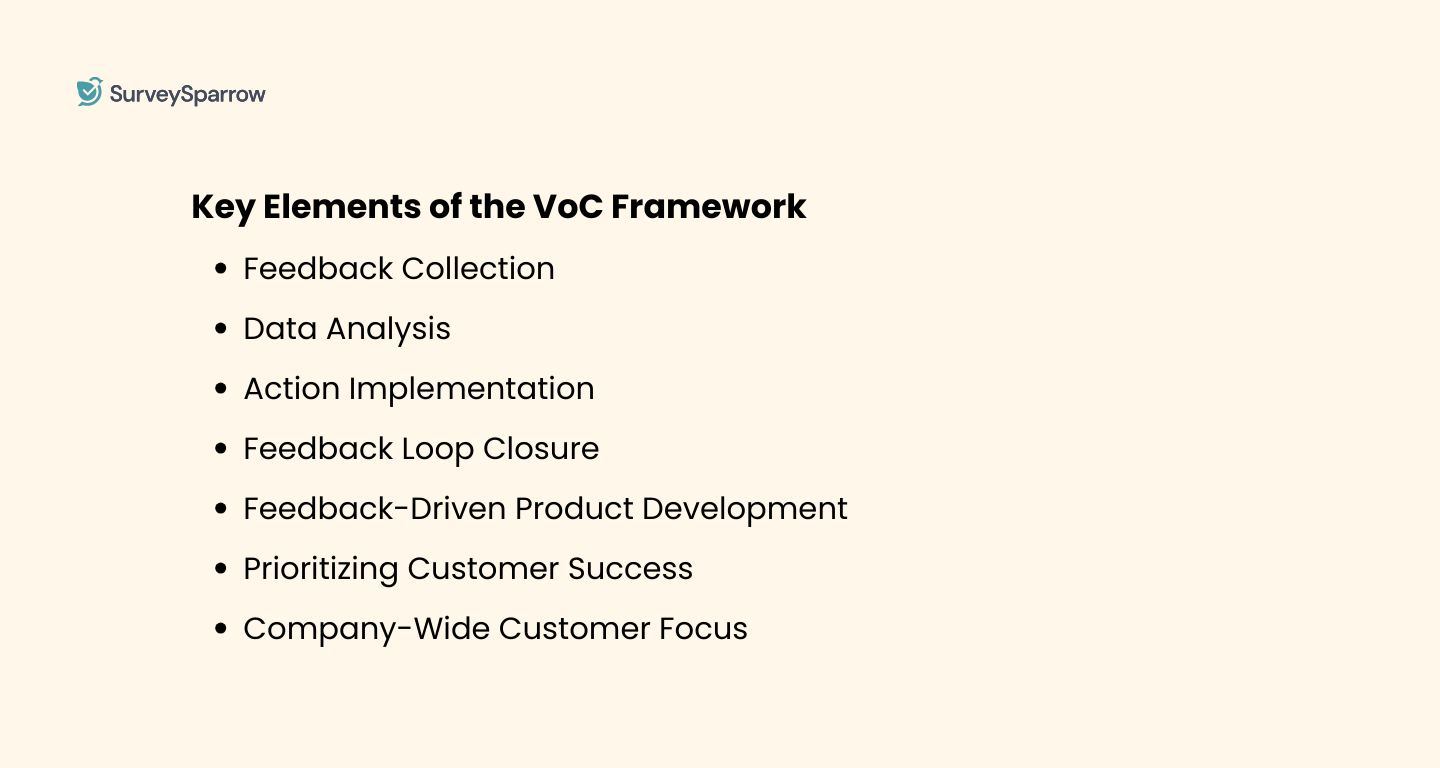VoC
A Complete Guide for Voice of Customer Framework for B2B SaaS Enterprises
Article written by Kate Williams
Content Marketer at SurveySparrow
15 min read
19 September 2025

In the growing B2B SaaS enterprise sector, it is crucial to understand what customers need and prefer to drive growth and deliver outstanding experiences. This is where the Voice of the Customer (VoC) framework comes in.
By collecting and analyzing customer feedback, Voice of the Customer framework help organizations gain valuable insights and make decisions based on data.
In this blog post, we will explore the three best Voice of the Customer framework for B2B SaaS companies, highlighting their benefits and providing practical advice for leveraging them effectively. Let’s dive in!
What is Voice of Customer Framework?
In B2B SaaS (Business-to-Business Software as a Service), the Voice of the Customer Framework is a complete plan that focuses on collecting, analyzing, and responding to what customers say. This method is really important for SaaS companies that work with business clients. It helps these companies understand and meet the specific needs and wants of their business customers. This makes sure they create solutions that their customers really like, which helps increase customer loyalty and grow their business.
Key Elements of the VoC Framework
Feedback Collection:
This involves actively collecting customer opinions through various means like surveys, interactions with support teams, and direct conversations. It’s about listening to what customers have to say in different scenarios.
Data Analysis:
Here, the focus is on dissecting the gathered feedback to extract valuable insights. This step involves identifying customer needs, preferences, and spotting emerging trends, which helps in understanding the customer base better.
Action Implementation:
This is about taking the insights gained from the data analysis and putting them into action. It could mean making adjustments to products or services to better align with customer expectations and needs.
Feedback Loop Closure:
It’s important to communicate back to customers about the changes made in response to their feedback. This step demonstrates that their input is valued and taken seriously, enhancing customer trust and engagement.
Feedback-Driven Product Development:
This element emphasizes adapting and evolving the product based on customer feedback. It ensures that the product development process is aligned with what customers actually need and want.
Prioritizing Customer Success:
The framework focuses on ensuring that customers achieve their goals using the product. This approach not only enhances customer satisfaction but also builds loyalty.
Company-Wide Customer Focus:
This involves creating a culture where customer feedback is a priority across all departments. It ensures a unified approach to responding and adapting to customer needs.
Voice of the Customer Vs Customer Experience
While VoC and customer experience (CX) are closely related, they are not the same thing. Customer experience focuses on the overall perception customers have during their interactions with a company, including the touchpoints, processes, and emotions involved.
On the other hand, VoC is specifically concerned with collecting and analyzing customer feedback to gain insights into their needs and expectations.
VoC research serves as a foundation for enhancing the customer experience. Thus, by leveraging the insights obtained through VoC frameworks, businesses can make targeted improvements to their products, services, and processes, resulting in a better overall customer experience.
How Beneficial is the Voice of Customer Framework?
The Voice of the Customer (VoC) Framework is highly beneficial for B2B SaaS (Business-to-Business Software as a Service) companies in several significant ways:
Enhanced Product Development:
By incorporating direct customer feedback into the product development process, SaaS companies can create more relevant and user-friendly products. This leads to solutions that better meet the specific needs of business clients.
Improved Customer Satisfaction and Loyalty:
Understanding and acting on customer feedback helps address pain points and improve the overall user experience. This increases customer satisfaction, which can lead to higher retention rates and customer loyalty.
Competitive Advantage:
Companies that effectively use the VoC Framework often gain a competitive edge. They are more in tune with their customer’s needs and can adapt more quickly to market changes, setting them apart from competitors who may not be as customer-centric.
Increased Revenue and Growth:
Satisfied customers are more likely to upgrade, purchase additional services, and recommend the product to others. This can lead to increased revenue and growth for the SaaS company.
Better Customer Insights and Market Understanding:
The VoC framework provides deep insights into customer needs, preferences, and trends. This information is crucial for strategic planning and helps in making informed business decisions.
How do you get started with the VoC framework?
Understanding the VoC Basics
Grasp the VoC Concept: Understand that VoC is about capturing, analyzing, and acting on customer insights. It’s essential for tailoring your SaaS product to meet customer needs and expectations effectively.
Identifying Customer Touchpoints
Map the Customer Journey: Pinpoint where customers interact with your product, such as during onboarding, regular usage, and support interactions. Recognize these moments as opportunities for gathering valuable feedback.
Setting Up Feedback Mechanisms
Choose the Right Tools: Opt for tools that seamlessly integrate into your service, like surveys for direct customer feedback. Consider platforms like SurveySparrow, which can be subtly introduced to gather insightful feedback without disrupting the user experience.
Designing and Implementing Feedback Systems
Craft Meaningful Questions: Develop questions that elicit detailed and actionable insights. Ensure they’re tailored to extract the most relevant information from your specific customer base.
Analyzing Feedback and Taking Action
Analyze and Act: Utilize the feedback to make informed decisions about product improvements, service enhancements, or business strategies. Regularly update your approach based on this continuous feedback loop.
Iteration and Continuous Improvement
Adopt an Iterative Approach: Treat VoC as an ongoing process, regularly refining your strategies based on new insights and evolving customer needs.
10 Best VoC Framework Questions Examples
Creating effective Voice of the Customer (VoC) questions is key to unlocking valuable insights for your B2B SaaS enterprise. Here are 10 sample questions that can help you gather meaningful data while maintaining a subtle and natural approach:
Product Related Questions
1. “What specific features of our product do you find most beneficial for your business operations?”
This question aims to identify the strengths of your product from the customer’s perspective.
2. “What three words would you use to describe our product?”
This simple yet effective question can yield powerful insights into customer perception and brand identity.
3. “How would you rate your overall experience with our customer support team?”
Understanding the effectiveness of your customer service can highlight areas for development or strengths to maintain.
4. “Can you share a recent experience with our product that stood out to you, positively or negatively?”
Captures specific customer experiences, offering insights into both the highs and lows of their journey.
5. “How likely are you to recommend our product to other businesses? (On a scale of 1-10)”
A classic Net Promoter Score (NPS) question that gauges customer satisfaction and loyalty.
Product Enhancement Questions
6. “In what ways could our product be enhanced to better meet your business needs?”
Directly ask for suggestions, indicating that you value their input and are committed to improvement.
7. “What motivated you to choose our product over competitors?”
Helps in understanding your unique selling points from a customer’s viewpoint.
8. “If you could add one feature to our product, what would it be and why?”
Opens the floor for innovative ideas directly from the user base.
9. “How well does our product integrate with your existing workflows and systems?”
Assessing product compatibility and ease of integration can provide critical feedback for SaaS products.
10. “Are there any challenges you’ve encountered while using our product? If yes, could you please describe them?”
This encourages customers to share any pain points or difficulties, providing you with direct feedback for improvement.
While integrating these questions into your feedback mechanisms, consider using a platform like SurveySparrow to seamlessly gather and analyze these insights. It’s a subtle yet powerful way to ensure your VoC efforts are as effective and user-friendly as possible.

Create conversational customer surveys with SurveySparrow
A personalized walkthrough by our experts. No strings attached!
Best 3 Frameworks Ideal for B2B SaaS Enterprises for Collecting Feedback
A VoC framework is a structured approach that guides organizations in capturing, analyzing, and utilizing customer feedback effectively. While there are various frameworks available, three stand out as particularly beneficial for B2B SaaS enterprises:
1. Net Promoter Score (NPS)
NPS is a widely used VoC framework that measures customer loyalty and satisfaction by asking a simple question: “On a scale of 0 to 10, how likely are you to recommend our product/service to others?”
Hence, based on their responses, customers are classified as promoters, passives, or detractors. NPS provides valuable insights into customer sentiment and helps identify areas for improvement.

2. Customer Effort Score (CES)
CES focuses on measuring the ease or difficulty customers experience while interacting with a company. Thus, by asking questions such as, “How easy was it to use our product?” or “How much effort did you have to put in to resolve your issue?” businesses can identify pain points and streamline processes to reduce customer effort.
3. Sentiment Analysis
Sentiment analysis involves the automated processing and analysis of customer feedback, such as online reviews, social media posts, and customer service interactions, to determine the overall sentiment expressed.
Hence, this technique provides a quantitative measure of customer sentiment allowing businesses to identify trends in customer feedback.
For B2B SaaS companies, certain VoC frameworks are particularly well-suited. Here are three of the best frameworks for collecting feedback
To Collect Feedback
1. Product-Market Fit Surveys:
These market research surveys gauge the extent to which a company’s product or service meets the needs and expectations of its target market. By measuring product-market fit, B2B SaaS enterprises can identify areas for improvement and align their offerings with customer requirements.
2. Customer Advisory Boards:
These boards consist of selected customers who provide valuable feedback, advice, and insights to the company.
Therefore, by engaging with key customers, B2B SaaS enterprises can gain a deeper understanding of their needs, preferences, and pain points, enabling them to develop products and services that better cater to their target audience.
3. User Onboarding Feedback:
User onboarding is a critical phase in the customer journey for B2B SaaS companies. Thus, by actively seeking feedback from users during onboarding, businesses can identify usability issues, improve the onboarding experience, and increase user adoption and retention rates.
Common Challenges of Implementing VoC Framework
1. Data Overload:
Issue: With the VoC framework, companies often face the challenge of dealing with a massive influx of customer feedback coming in from multiple channels like social media, surveys, customer service interactions, and more.
Impact: This abundance of data can be overwhelming, making it difficult to sort, prioritize, and analyze effectively. There’s a risk of important insights getting lost in the noise, and the task of managing this data can be resource-intensive.
2. Integrating Feedback:
Issue: Another significant challenge is the integration of customer feedback into tangible product development and service improvement. This involves not just understanding the feedback but also determining how to apply it in a way that benefits the product and meets customer expectations.
Impact: The process can be complex, as it requires coordination between various teams, including product development, marketing, and customer service. There’s also the challenge of balancing customer demands with the company’s vision and technical feasibility.
3. Consistent Customer Engagement:
Issue: Keeping customers continuously engaged to provide ongoing feedback is a tricky aspect. Customers may initially be enthusiastic about giving feedback, but sustaining this interest over time can be challenging.
Impact: With consistent engagement, the flow of feedback can become consistent, making it easier to obtain a current and accurate understanding of customer needs and experiences.
4. Analyzing Qualitative Data:
Issue: Qualitative feedback, such as open-ended survey responses or comments, often contains valuable insights but is more challenging to analyze than quantitative data.
Impact: This type of data requires sophisticated tools and skilled analysts to interpret nuances and subjective opinions. The process can be time-consuming and may require significant resources to ensure accurate and useful insights are extracted.
5. Organizational Alignment:
Issue: Ensuring that every department within the company, from product development to sales and marketing, understands and acts on customer feedback consistently is a substantial challenge.
Impact: Lack of alignment can lead to mixed messages being sent to customers and missed opportunities for improvement. It requires a concerted effort to create a company culture where customer feedback is valued and acted upon across all levels and departments.
3 Key Strategies for Achieving Growth through a Voice of the Customer Model
Implementing a VoC model successfully requires careful planning and execution. Here are three essential pieces of advice for driving growth with a VoC framework:
1. Collect Actionable Feedback:
Focus on obtaining feedback that provides actionable insights. Design surveys and interview questions that uncover specific pain points, needs, and expectations of your target audience.
Also, this will help you prioritize improvements and drive meaningful changes within your organization.
2. Actively Listen to Your Customers:
It’s not enough to collect feedback; you must also actively listen to your customers. Respond promptly to their concerns and suggestions, and demonstrate that their feedback is valued.
Thus, engaging in two-way communication fosters trust and strengthens the customer relationship.
3. Align VoC with Business Objectives:
To drive growth, ensure that your VoC efforts align with your overall business objectives. Use the insights gathered to inform strategic decisions, product development, and marketing strategies.
Thus, by integrating VoC into your organizational processes, you can foster a customer-centric culture and drive sustainable growth.
Wrapping Up
Voice of the Customer frameworks plays a vital role in helping B2B SaaS enterprises to understand customer needs, and enhance experiences, and growth.
Starting with the VoC framework is a transformative step for B2B SaaS enterprises, fostering a deeper understanding of customer needs and driving strategic improvements. It’s a journey of continuous learning and adaptation, where customer feedback becomes the cornerstone of your product development and business strategies. Remember, integrating a tool like SurveySparrow can make this journey smoother, offering an unobtrusive yet effective way to capture the voice of your customers.

Create conversational customer surveys with SurveySparrow
A personalized walkthrough by our experts. No strings attached!
Whether through the use of established frameworks like NPS, CES, or sentiment analysis or through alternative models can be tailored to specific business requirements. Organizations can unlock the power of customer feedback to stay ahead in the competitive SaaS landscape.
Embracing the Voice of the Customer is a key step toward building lasting customer relationships and achieving long-term success.

Turn feedback into growth. Try SurveySparrow’s VoC platform free today!
Kate Williams
Related Articles

VoC
5 Better & Cheaper GetFeedback Alternatives for CX Teams in 2025
18 MINUTES
8 August 2025

VoC
Small Business Voice of Customer Software: Which Tool Saved Us $5,000?
14 MINUTES
27 October 2025

VoC
Top 10 Voice of Customer (VoC) Tools to Look for in 2025
17 MINUTES
9 March 2024

VoC
VoC ROI Measurement: From Raw Data to Revenue Impact
14 MINUTES
19 September 2025

